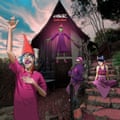Here’s a sobering thought for anyone old enough to recall the early 00s first-hand: Cracker Island arrives 22 years on from Gorillaz’s debut single, Clint Eastwood. Founded by Damon Albarn, an alt-rock star apparently dabbling in pop, and his former flatmate Jamie Hewlett, who supplied the cartoons, it was a project you might have assumed would be a short-lived joke. But nearly a quarter of a century on, Gorillaz have made as many studio albums as Albarn’s primary band and, in the process, have achieved things Blur haven’t: a string of US Top 10 albums, one of them double-platinum; a Grammy; and entente cordiale with Oasis – or at least Noel Gallagher, who appeared on 2017’s We Got the Power.
They’ve also proved oddly prescient. You don’t hear many bands who sound like Blur these days, but we live in an era when pop is fuelled by the kind of cross-genre collaborations that started popping up on Gorillaz’s eponymous debut album and had more or less consumed their output entirely by the release of 2010’s Plastic Beach. In truth, their current prevalence probably has more to do with trying to game the streaming services’ genre-specific playlists than Gorillaz’s influence, but still. You can see the mark their tracks Feel Good Inc and Dirty Harry left on Gen Z’s nascent musical taste by the fact that Gorillaz are still playing arenas and headlining festivals years after their albums stopped shifting in the kind of quantities they once sold; last year, Billie Eilish said Albarn “changed my life” when she invited him to sing Feel Good Inc with her at Coachella.
That Gorillaz’s albums don’t automatically go platinum any more is no reflection on their quality, something underlined by Cracker Island. As with Plastic Beach and Humanz, it’s a Gorillaz album that comes with a concept attached, although the concept feels even more vague and disconnected from the music than previously. Cracker Island is loosely based around a quasi-religious cult, which seems only tangentially connected to the themes of the title track, Oil and Silent Running – all of which give every impression of being about the perils of the metaverse and living online, “a made-up paradise where the truth was Auto-Tuned” as the title track puts it. Indeed, Baby Queen, which reflects on Damon Albarn’s chance meeting with a young member of Thailand’s royal family at a Blur gig, doesn’t seem at all relevant to the supposed concept.
But, much like the cartoon characters that supposedly make up Gorillaz’s lineup, the concept doesn’t really matter. What does is that Albarn seems to have fixed the problem that has dogged Gorillaz albums in the past – an overabundance of collaborators. Given that everyone from Lou Reed to Popcaan to Mavis Staples has agreed to work with the band previously, you can’t really blame Albarn for overstuffing the resulting albums’ contents, but it has occasionally made for unwieldy listening. Cracker Island doesn’t skimp on the big-name cameos – Bad Bunny, Tame Impala and Stevie Nicks all feature here – but it clocks in at a trim 10 tracks and 37 minutes. Moreover, it feels musically unified, majoring in a brand of synth-pop that only occasionally veers towards riffs as cartoonish as the characters that are supposed to have made them. For the most part, Cracker Island deals in subtlety and nuance.
It also offers an object lesson in Albarn’s skill and sensitivity in working with his guests. Pop collaborations often reveal their roots in commercial considerations too clearly, glomming together artists with more thought given to the buying power of their fanbases than to the musical results. But that’s never an accusation that can be thrown at Cracker Island. Only Bad Bunny feels as if he is doing a star turn: most of the reggaeton-influenced Tormenta is ceded to his Spanish-language vocal, befitting his current status as the world’s biggest pop star.
Elsewhere, there’s a distinct sense of everyone working in service of some of the best pop songs Albarn has written in an age: Thundercat’s bass and backing vocals weaving around Albarn’s voice on the title track; Stevie Nicks improbably singing about drum’n’bass on Oil; Beck and Adeleye Omotayo bolstering, rather than dominating, Albarn’s performances on Possession Island and the superb Silent Running. Accordingly, there isn’t any sense of waning interest when Cracker Island’s tracks come without cameo appearances: Baby Queen and The Tired Influencer offer particularly luminous examples of Albarn’s trademark melancholy melodies.
Cracker Island is small where Gorillaz albums have tended to sprawl. Divorced from cartoon alter egos, big concepts and Albarn’s apparently limitless power to persuade big stars to do his bidding, it reveals itself as that most prosaic of things: a fantastic pop album. Gorillaz hail from an era when dabbling in pop was something an alt-rock star could only be doing ironically, as if to underline its ephemerality, before getting back to something more worthy and serious – another reason why people might have assumed the project would be short-lived. But if you thought that 22 years ago, you were clearly wrong – something Cracker Island makes abundantly clear.
after newsletter promotion
This week Alexis listened to
The Blessed Madonna and Jamie Principle – We Still Believe
Marea Stamper’s 21st-century take on acid house meets authentic acid pioneer Principle, protesting against “racist, fascist shit” and sermonising to a dancefloor still packed on Sunday morning.

